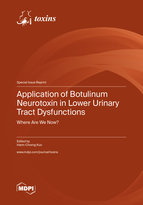Application of Botulinum Neurotoxin in Lower Urinary Tract Dysfunctions: Where Are We Now?
A special issue of Toxins (ISSN 2072-6651). This special issue belongs to the section "Bacterial Toxins".
Deadline for manuscript submissions: closed (31 December 2022) | Viewed by 27364
Special Issue Editor
Interests: botulinum neurotoxin; neurourology; urodynamics; female urology; stress urinary; incontinence; LUTS
Special Issues, Collections and Topics in MDPI journals
Special Issue Information
Dear Colleagues,
In recent decades, botulinum toxin A has been widely used in the treatment of several lower urinary tract dysfunctions (LUTDs), such as overactive bladder syndrome (OAB), neurogenic detrusor overactivity (NDO), interstitial cystitis (IC), and voiding dysfunction. Although botulinum toxin A intravesical injection has been approved for OAB and NDO, the other application of this neurotoxin in LUTDs is yet to be approved. Because some clinical experiences of adverse events have limited its wide application, this treatment has gradually been considered as an unpopular procedure for LUTDs. However, evidence has shown that botulinum toxin A has advantages in LUTDs compared with oral pharmacological medications, especially in elderly OAB patients with cognitive dysfunction, patients with bladder neck dysfunction or dysfunctional voiding, idiopathic voiding dysfunction due to poor relaxation of the external sphincter, or intractable bladder pain syndrome due to IC or ketamine-induced cystitis, male patients with lower urinary tract symptoms and a small prostate, and pediatric patients with OAB or dysfunctional voiding. In addition, botulinum toxin A can also be carried across the urothelial barrier by the aid of bladder treatment such as liposomes or low-energy shock waves. There are several LUTDs other than OAB and NDO that can benefit from botulinum toxin A injection or intravesical instillation. This Special Issue welcomes original or review articles that fucus on the novel applications of botulinum toxin A in LUTDs, either in human or animal studies. The collection of this Special Issue of Toxins will provide updated knowledge and information on the current position of botulinum toxin A in functional urology and LUTDs.
Prof. Dr. Hann-Chorng Kuo
Guest Editor
Manuscript Submission Information
Manuscripts should be submitted online at www.mdpi.com by registering and logging in to this website. Once you are registered, click here to go to the submission form. Manuscripts can be submitted until the deadline. All submissions that pass pre-check are peer-reviewed. Accepted papers will be published continuously in the journal (as soon as accepted) and will be listed together on the special issue website. Research articles, review articles as well as short communications are invited. For planned papers, a title and short abstract (about 100 words) can be sent to the Editorial Office for announcement on this website.
Submitted manuscripts should not have been published previously, nor be under consideration for publication elsewhere (except conference proceedings papers). All manuscripts are thoroughly refereed through a double-blind peer-review process. A guide for authors and other relevant information for submission of manuscripts is available on the Instructions for Authors page. Toxins is an international peer-reviewed open access monthly journal published by MDPI.
Please visit the Instructions for Authors page before submitting a manuscript. The Article Processing Charge (APC) for publication in this open access journal is 2700 CHF (Swiss Francs). Submitted papers should be well formatted and use good English. Authors may use MDPI's English editing service prior to publication or during author revisions.
Keywords
- overactive bladder
- interstitial cystitis
- neurogenic detrusor overactivity
- voiding dysfunction
- lower urinary tract symptoms







